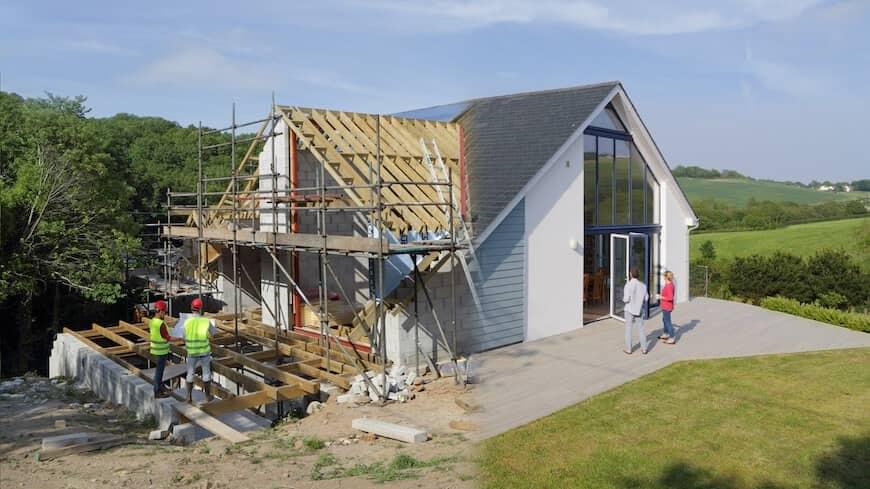How do construction loans work?


When you know exactly what you want in a house but can’t find a suitable listing, your next option could be to build it yourself. Will it cost more that way? Possibly. But that’s why construction loans exist: to help finance new homes.
And not only professional developers have access to these financing options. Any consumer with the right financial credentials can take advantage of construction loans.
Are you ready to explore how a construction loan could help you build that dream home? Apply now!
What is a construction loan?
A construction loan can be used to finance building a residential property. It may also be called a home-building loan, construction mortgage, “one-time close loan” or “two-time close loan.” A professional builder or a consumer can take out a construction loan for the purpose of building a house.
The loan is used to cover the cost of permits, materials, labor, and perhaps even the land itself.
In most cases, your builder will be given lump-sum payments at key stages throughout the building of the home to cover expenses. Once the funds are secured, there isn’t much for you to do as the homebuyer but sit back and let your builders work.
How does a construction loan work?
After you’ve located a parcel of land to serve as the site for your new home, you or your builder will need to get a construction loan. Not all mortgage lenders offer these types of loans, but your builder can point you in the right direction.
Once financing has been secured, the clock starts ticking. Unlike mortgages that often run for a long time, such as a , construction loans are short-lived.
Construction loans aim to last only as long as it takes to build the house, which is often around 9 to 12 months. Once construction is complete, the loan will need to be paid off or refinanced.
While you might not need to make payments on the until the build is completed, you’ll likely be on the hook for interest payments each month.
Homebuilding loans also typically come with higher interest rates than most other mortgage types, whether it’s a fixed rate, adjustable rate or even .
Types of construction loans
Homebuyers can consider three types of construction loans.
Construction-only loan
This basic construction loan covers the costs of building the home and nothing else. Once work is finished, you’ll repay the remainder of your loan balance or refinance the loan to bundle everything into your mortgage.
Though not common, a few government programs also support construction-only loans, most notably FHA and VA construction loan programs. These government agencies do not provide funding themselves, so you’ll still need to go through an approved lender for financing.
Construction-to-permanent loan
A construction-to-permanent loan provides the financing to pay for then is modified to a longer-term conventional loan once construction is complete. Unlike a construction-only loan, you won’t be required to complete two separate loan applications with this option, and you’ll pay one down payment and one set of .
Owner-builder / Self-build loan
The funds from a construction loan usually go directly to your builder. But if you’re a contractor or homebuilder, you may qualify for an owner-builder loan and receive that money yourself. This option would essentially remove a third-party contractor from the process.
It means you alone will be responsible for building your home. And you’ll need to show your lender that you have the qualifications and experience to take on a project of this scale.
Construction loan interest rates
Lenders generally view investment in new construction as more risky than an existing building, so interest rates on construction loans typically run a bit higher than .
The good news is you may be able to refinance the loan once the build is complete. Refinancing could essentially allow you to bundle your construction loan into a new mortgage.
That could mean you’d have a larger loan amount than if you chose a single-close construction loan, but your interest rate could be significantly lower on the combined refinance. That could mean less interest due over the life of the loan as well as potentially lower .
Construction loans vs. conventional mortgages
A construction loan can be used to finance the building of a home with a builder that requires the buyer to make large payments at various stages throughout construction, such as setting the foundation, framing, drywalling and installing cabinetry.
But a construction loan isn’t always the only path. In many scenarios, such as buying from a subdivision or tract-style homebuilder constructing several or even hundreds of homes in one neighborhood, you could secure a more common home loan from your lender. There are generally more affordable conventional loans with options as low as 5% of the sale price.
Requirements for construction loans
Most lenders will likely have stricter requirements for a construction loan than they might with other mortgage products. While specific qualifications for construction loans will vary from lender to lender, they’ll focus on three common points: credit score, and cash on hand for down payment options
Lenders might also want to see a detailed layout of your homebuilding plan before agreeing to loan you the money to build it. You can almost think of it like a small-business loan: A bank will want to examine a business plan showing that funds will be put to good use before loaning money for the venture.
A conventional mortgage generally doesn’t require that kind of in-depth documentation. The closest comparison might be requirements, which verify the property itself will provide adequate collateral on the home loan.
How to get a construction loan
Lenders often use more rigorous criteria when vetting borrower credentials on construction loans, so you’ll want to be sure your lending profile is as strong as possible before applying for this kind of financing.
Before you get in too deep, be sure to consult a who can assess your situation, answer questions and help you make the best decision based on your circumstances.
is an early step that helps determine how much you can qualify to borrow. If you’re ready to get those hammers swinging, apply now!




